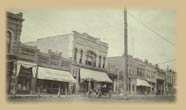

Home | What's New | Photos | Histories | Sources | Reports | Calendar | Cemeteries | Headstones | Statistics | Surnames

|

Home | What's New | Photos | Histories | Sources | Reports | Calendar | Cemeteries | Headstones | Statistics | Surnames |
| 1. | William Linville was born in 1770 in Surry Co, North Carolina (son of Moses Linville and Elizabeth Hester); died in 1850 in Coldwater, Wayne Co, Mississippi. William married Mary Jane Anderson about 1807. Mary was born in 1786; died after 1820 in of, Tennessee. [Group Sheet] [Family Chart] Children:
|
| 2. | Moses Linville was born in 1752 in Virginia (son of Thomas* Linville and Hannah* Morgan (?), (dau?)); died in 1826 in Surry Co, North Carolina. Other Events and Attributes:
Notes: Other-Begin: Moses married Elizabeth Hester about 1769. Elizabeth was born in 1749 in Belews Creek, Forsyth Co, North Carolina; died in 1810 in Union, Union Co, South Carolina. [Group Sheet] [Family Chart] |
| 3. | Elizabeth Hester was born in 1749 in Belews Creek, Forsyth Co, North Carolina; died in 1810 in Union, Union Co, South Carolina.
|
| 4. | Thomas* Linville was born in 1703 in Chichester, Chester Co, Pennsylvana (son of John* Linville, Sr. (Immigrant) and Mrs. (1st wife of John)* Linville); died before 1761 in Belews Creek, Stokes Co, North Carolina. Notes: Thomas Linvil Thomas* married Hannah* Morgan (?), (dau?) about 1746 in Pennsylvania. Hannah* (daughter of Edward Morgan, (immigrant) and Margaret Elizabeth Jarman (?)) was born on 19 Feb 1713 in Gwynedd, Montgomery Co, Pennsylvania; died in 1773 in North Carolina. [Group Sheet] [Family Chart] |
| 5. | Hannah* Morgan (?), (dau?) was born on 19 Feb 1713 in Gwynedd, Montgomery Co, Pennsylvania (daughter of Edward Morgan, (immigrant) and Margaret Elizabeth Jarman (?)); died in 1773 in North Carolina. Notes: her ancestors are here: Notes: Married in St.Pauls Episcopal Church. (not verified)
|
| 8. | John* Linville, Sr. (Immigrant) was born in 1677 in Sussex Co, England (son of Richard* Linville, (Immigrant) and Mary* Hart, (Immigrant)); died after 1739 in of, Pennsylvania. Other Events and Attributes:
Notes: The story of this historical marker begins with the story of children. John* married Mrs. (1st wife of John)* Linville about 1702 in Pennsylvania. (1st was born about 1677; died after 1710 in of, Pennsylvania. [Group Sheet] [Family Chart] |
| 9. | Mrs. (1st wife of John)* Linville was born about 1677; died after 1710 in of, Pennsylvania.
|
| 10. | Edward Morgan, (immigrant) was born about 1650 in Llantarnam, Wales; died after 1734 in Gwynedd, Berks Co, Pennsylvania. Other Events and Attributes:
Notes: THE MORGAN LOG HOUSE -- This 1695 medieval, 2 1/2 story log house, the only one of its kind still surviving in America, was built by grandparents of Daniel Boone, the frontiersman, and forebears of General Daniel Morgan famed Revolutionary War raider." In this house the American roots of a distinguished family tree were planted. Besides Morgan offspring, Rittenhouse, Morris, Roberts, Lloyd, Robeson and Hanks are family names on its branches. The latter being ancestors of Abraham Lincoln, Lowell Thomas, the explorer, broadcaster-author, is a descendant. Eminent local Morgans include Walter L. Morgan, a pioneer in the mutual fund industry, founder of the Willington Fund and Wellington Mgt. Co., manager of 14 Vanguard funds. This cabin erected on an 800 acre site by well-to-do Welch Quaker Edward Morgan. Near Gwynedd, PA, site of historic William Penn Inn, The Morgan House adjoins Valley Force road and Allentown Road. The latter was the escape route taken by those escorting the Liberty Bell to be hidden in Allentown's Zion Church. Morgan House is open to the public on Saturdays and Sundays from 1-5 p.m. Tel: (215) 368-2480. Edward Morgan's son, Morgan, had built a house on 197 acres of the original 800 acres in 1718. Edward married Margaret Elizabeth Jarman (?) about 1686 in Gwynedd, Philadelphia Co, Pennsylvania. Margaret was born about 1670 in Radnor, Delaware Co, Pennsylvania; died in 1730 in of, Pennsylvania. [Group Sheet] [Family Chart] |
| 11. | Margaret Elizabeth Jarman (?) was born about 1670 in Radnor, Delaware Co, Pennsylvania; died in 1730 in of, Pennsylvania.
|